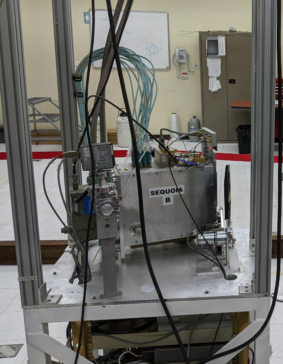SEQUOIA
SEQUOIA is a cryogenic focal-plane array of 16 pixels, arranged in a 4×4 array, that operates in the range 85 – 115 GHz. The array, which is feed by square horns separated by 2 f λ, is cooled to 18K and use low-noise Indium Phosphide (InP) monolithic microwave integrated circuit (MMIC) preamplifiers designed at UMass to provide a characteristic receiver noise of 55K in the range 85-107 GHz, increasing to 90K at 115 GHz. Table 1 shows the specifications of this receiver.

Table 1: Specifications of the SEQUOIA receiver.

Figure 1: SEQUOIA has two LO frequency options. Depending on whether the 80.4 or 120.6 GHz LO is chosen the band of 85-100 GHz or 100-115 GHz is sent down to the 5-20 GHz IF band.
SEQUOIA was the workhorse facility instrument for the FCRAO 14-m telescope for many years. Installed at the LMT in 2017, the refurbished SEQUOIA has a new digital spectrometer with a total bandwidth options of 200, 400, and 800 MHz. All pixels of the array track the same frequency window, so nominally a single spectral line is observed at a time by the array. However, we note that in some cases two lines may fall within the same spectral window so that they may be imaged simultaneously (e.g. HCO+ J=1-0 and HCN J=1-0 in the 800 MHz bandwidth mode of the spectrometer).
Relevant information to be considered when requesting observing time with SEQUOIA can be found it the SEQUOIA Observing Summary. Sensitivity and integration time calculators for SEQUOIA are available in LMT-Hedwig, the LMT’s proposal submission system.





